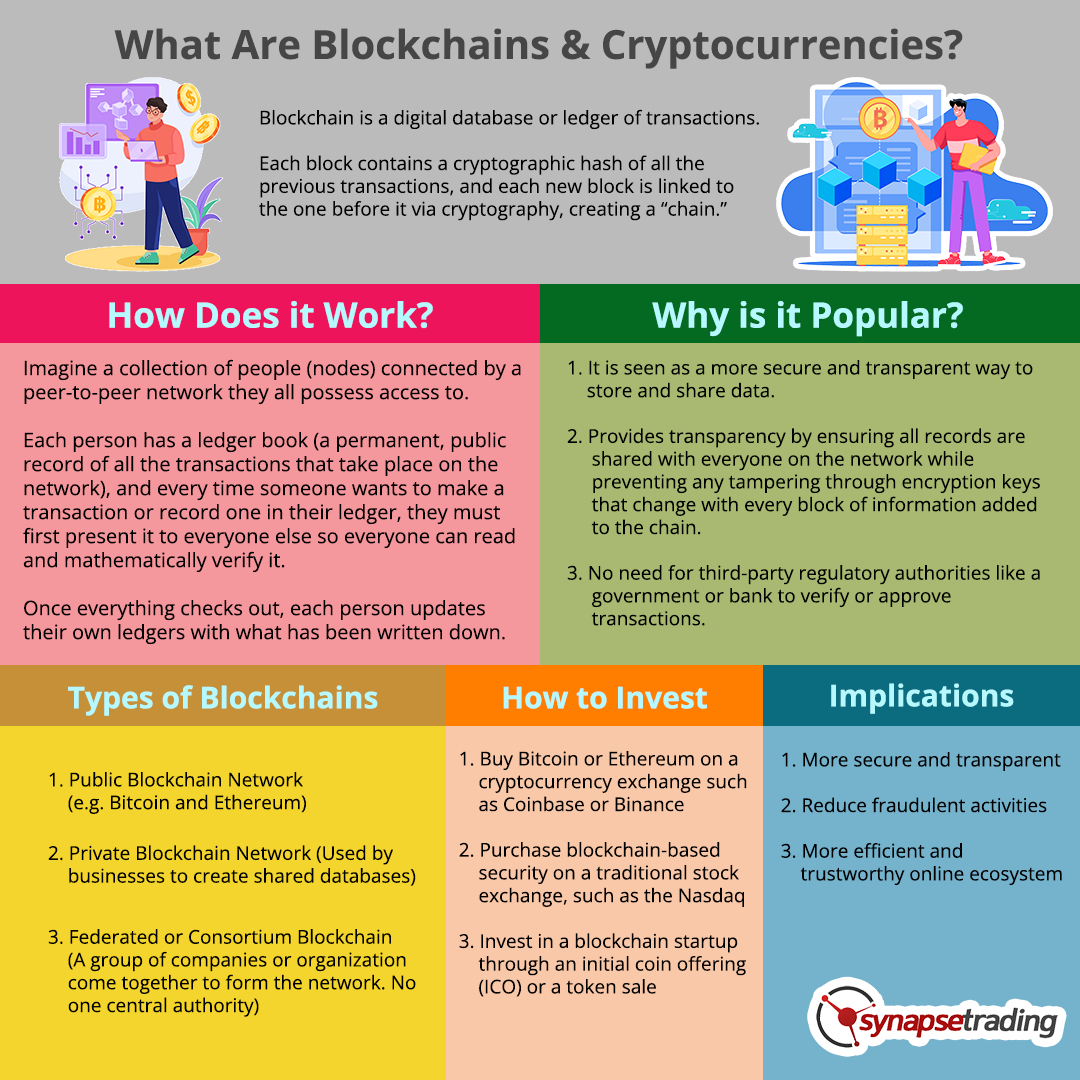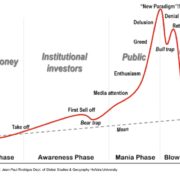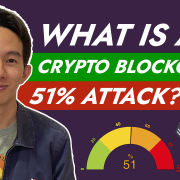What are Blockchains & Cryptocurrencies?
Join our Telegram channel for more market analysis & trading tips: t.me/synapsetrading
Why are blockchains touted as the next big thing in the financial industry and potentially a major game-changer?
If you have heard of blockchain technology, chances are you know it has something to do with bitcoin, decentralised finance or cryptocurrency.
And while those two things have become inextricably linked, they are not the same.
That’s why it is crucial to understand how they work now so that you can take advantage of that potential — both as an entrepreneur and a consumer.
In this blog post, I will tell you everything you should know about how blockchain technology works and what its impact could be going forward.
Table of Contents
History of Blockchains
Blockchain technology has a long and complicated history.
It was first conceptualized in 1991 by a group of researchers trying to create a system for timestamping digital documents so they could not be tampered with.
But it was not until 2008 that blockchain really came into its own when Satoshi Nakamoto first introduced the concept of blockchains in a white paper entitled Bitcoin: A Peer-to-Peer Electronic Cash System.
In this paper, Nakamoto described how a decentralized ledger could be used to record and verify transactions instead of the unstable traditional banking system.
Since then, blockchain has been hailed as a revolutionary new way of handling data.
What is a Blockchain?
At its simplest, blockchain is a digital database or ledger of transactions.
When someone uses cryptocurrency to buy something, they broadcast their transaction to the entire network of computers running the software.
These computers then race to verify the transaction, and the first one to do so adds it to the chain of past transactions or “block.”
The new block is then broadcast to the network and verified by more computers, and so on.
Each block contains a cryptographic hash of all the previous transactions, and each new block is linked to the one before it via cryptography, creating a “chain.”
How Does Blockchain Technology Work?
It can be difficult to understand how blockchain works by looking at its front-end alone.
The best way to describe blockchain technology is via an analogy…
Imagine a collection of people (nodes) connected by a peer-to-peer network they all possess access to.
Each person has a ledger book (a permanent, public record of all the transactions that take place on the network), and every time someone wants to make a transaction or record one in their ledger, they must first present it to everyone else so everyone can read and mathematically verify it.
Once everything checks out, each person updates their own ledgers with what has been written down.
As soon as this happens, each node checks to see if anyone has rejected the entry — if no one did, it is complete!
If someone did, this entire process starts over again until there is consensus across all nodes.
How is a Blockchain Different from a Typical Database?
A typical database is more vulnerable to data breaches and hacking because it is centralized, meaning all the data is stored in one place.
On the other hand, a blockchain is decentralized, meaning the data is spread across multiple computers across the decentralized network.
This makes it much more difficult for hackers to access and tamper with the data.
Why is Blockchain Technology Popular?
Blockchain technology is popular because it is seen as a more secure and transparent way to store and share data.
In theory, blockchain technology is highly secure as it is impossible to hack into multiple nodes at once without significant resources.
It also provides transparency by ensuring all records are shared with everyone on the network while preventing any tampering through encryption keys that change with every block of information added to the chain.
This makes it ideal for storing sensitive information like financial transactions.
Plus, since blockchain is decentralized, there is no need for third-party regulatory authorities like a government or bank to verify or approve transactions.
This makes the process faster and more efficient.
As we make our way to ‘Web 3.0’, one of the most popular applications of blockchain technology today is in the form of non-fungible tokens (NFTs).
NFTs are digital assets that are unique and cannot be replicated. They can be used to represent anything from art and collectibles to digital experiences and gaming items.
Because of their unique nature, NFTs have become extremely popular in recent years. In 2021 alone, the market for NFTs surpassed USD 40 Billion.
How to Process Transactions on a Blockchain?
Blockchain-based systems use what is called a hash function to encrypt transaction data. A hash function is a mathematical algorithm that takes input data of any size and converts it into output data of a fixed size.
The output of a hash function is commonly referred to as a hash or hash value.
In a blockchain, every transaction is stored in a block.
Each block has its own cryptographic hash and timestamp, as well as other data that may be specific to that block.
The blocks are stacked on top of each other, creating a digital ledger or chain of blocks.
This process is done through cryptography, which provides security and tamper-proofing for every block in the chain.
The hash from each block is used to create another cryptographic hash for each subsequent block, forming an unbroken chain and linking it all together.
For a new block to be added to the chain, miners must solve a complex mathematical problem.
This problem is known as the proof of work. Once a miner solves the proof of work, they can add the new block to the chain and they are rewarded in cryptocurrency for doing so.
The pieces of data stored in one block cannot be changed without changing all subsequent blocks; doing so would invalidate all following hashes and require massive amounts of computing power just to make a single change.
Types of Blockchains
Blockchain networks can be either public or private.
A public blockchain network is a decentralized network that anyone can join.
Bitcoin and Ethereum are examples of public blockchain networks.
A private blockchain network is a permissioned network where only approved participants can join.
Private blockchain networks are often used by businesses to create shared databases.
There is also a federated or consortium blockchain. In this type of blockchain, there is no one central authority.
Instead, a group of companies or organizations (known as a consortium) come together to form the network.
Each member of the consortium operates a node and has a vote in decision-making.
This type of blockchain is often used in industries where multiple parties must securely share data or conduct transactions, such as banking or supply chain management.
How to Invest in Blockchains?
There are several ways to make your first blockchain investment.
The most common way is to buy Bitcoin or Ethereum on a cryptocurrency exchange such as Coinbase or Binance.
Alternatively, you can purchase blockchain-based security on a traditional stock exchange, such as the Nasdaq.
Finally, you can invest in a blockchain startup through an initial coin offering (ICO) or a token sale.
When it comes to investing in blockchain technology, there are a few things you should keep in mind:
- The cryptocurrency market is highly volatile. This means that prices can fluctuate wildly from day to day, and you could lose a significant amount of money if you are not careful.
- You should only invest as much money as you are comfortable losing. Remember, there is always a risk of losing your entire investment when dealing with cryptocurrencies.
- Finally, make sure you do your research before investing in any blockchain-based project. There are a lot of scams out there, and it is important to know what you are getting yourself into before putting any money down.
What are the Implications of Blockchain Technology?
As the technology behind Bitcoin and other cryptocurrencies, blockchain has the potential to revolutionize the way we interact with the digital world.
With its distributed ledger system, blockchain offers a new way of storing and verifying data that is more secure and transparent than traditional methods.
In addition, blockchain could help reduce fraudulent activities, such as identity theft and money laundering.
Ultimately, this could lead to a more efficient and trustworthy online ecosystem.
Concluding Thoughts on Blockchain
Overall, blockchain technology is a way to store and transmit information in a secure, decentralized manner.
Blockchain technology can provide greater transparency and security for online transactions by using a distributed database.
Additionally, blockchain technology has the potential to streamline many business processes and reduce costs.
However, the full potential of blockchain technology has yet to be realized.
As the technology continues to evolve, we can expect to see even more innovative applications of blockchain technology in the future.
Now that you know a little more about how blockchain technology works, what do you think of it?
Do you think it has the potential to revolutionize our financial ecosystem?
And besides the finance world, what other real-world applications do you foresee it being used for?
Let me know in the comments below!

If you would like to learn more about crypto & DeFi, also check out: “The Ultimate Guide to Blockchain & Cryptocurrencies”
 Our flagship mentoring program is suitable for both beginners and advanced traders, covering the 4 strategies which I used over the past 15 years to build up my 7-figure personal trading portfolio.
Our flagship mentoring program is suitable for both beginners and advanced traders, covering the 4 strategies which I used over the past 15 years to build up my 7-figure personal trading portfolio.
 If you're looking for a reputable brokerage that covers all products (SG stocks, US stocks, global stocks, bonds, ETFs, REITs, forex, futures, crypto) and has one of the lowest commissions, this is what I currently use.
If you're looking for a reputable brokerage that covers all products (SG stocks, US stocks, global stocks, bonds, ETFs, REITs, forex, futures, crypto) and has one of the lowest commissions, this is what I currently use.
After trading for 18 years, reading 1500+ books, and mentoring 1000+ traders, I specialise in helping people improve their trading results, by using tested trading strategies, and making better decisions via decision science.














Leave a Reply
Want to join the discussion?Feel free to contribute!